Intro & Key Highlights
Introduction
From generating brand awareness and engagement to driving leads and pipeline, to ensuring exceptional customer experiences, Go-To-Market (GTM) teams have a lot on their plate. Marketing, sales, and customer service/success leaders that make up GTM teams are increasingly tasked with creating alignment and cohesiveness across departments, finding and implementing the right technology to satisfy cross-departmental needs, and generally doing more with less all around.
It is no surprise that efficiency gains are top of mind for GTM teams in the year ahead. Enter Artificial Intelligence (AI). AI is changing the way businesses operate, and has become widely associated with the idea of “getting more done.” And while 87% of GTM teams we surveyed use AI more now than they ever expected to, adoption rates across GTM departments are still relatively low. Three-quarters of GTM teams have access to AI, however, just 29% of GTM leaders report using AI to a great extent for their jobs.
With 97% of AI-users reporting that AI has had a positive impact on helping them achieve their goals, there is ample room for improvements in efficiency and overall business performance through AI adoption.
In the report that follows, Aptitude 8 set out to discover how GTM teams are currently using AI, the impact that AI has had on GTM strategy, what makes a successful AI-enabled technology stack, and where we can expect GTM teams to benefit from AI in the coming years. By partnering with Ascend2 Research to survey 275 GTM leaders across marketing, sales, customer service/success, and executive teams, we were able to answer these, and many other questions around the use of AI. We hope you enjoy the report!
Key Highlights

Room for improvement.
Three-quarters of GTM teams have access to AI, but just 29% of GTM leaders report using AI to a great extent for their jobs.

AI makes an impact.
Teams that use AI are more likely to meet their goals. And the more you use it, the bigger the impact.

More than just marketing.
Marketing teams use AI more than other GTM departments. Sales teams use it the least…. But sales and service departments expect major increases in the ways they are using AI in the year ahead.

Built-in is better.
AI that is built-in to technology you already use has higher adoption and a bigger impact on performance against goals… But, right now most companies (73%) don’t have built-in solutions in their existing stack.

Robots aren't replacing people yet.
Most companies are increasing hiring as a result of AI, placing importance on AI skills. In fact, over half of companies already have or plan to hire someone to oversee the use of AI. Very few companies are decreasing their hiring due to efficiency gains.

HubSpot users are winning.
HubSpot users are almost twice as likely to have seen significant increases in their ability to achieve goals and are more likely to see an extremely positive impact from AI than those who do not use HubSpot.
What are GTM teams prioritizing?
2023 presented GTM teams with many challenges to their ability to meet goals: Uncertain economic variability, shifting buying habits, and mass layoffs. Looking ahead to 2024, we asked GTM leaders what their teams are doing to meet and exceed their goals in the coming year.
GTM teams are focused on department alignment.
Strengthening marketing, sales, and customer success alignment is a top priority for over half of GTM team members surveyed, and the most commonly reported area of focus overall. Team alignment is a consistent priority across all GTM departments surveyed.
What are your top GTM priorities in the year ahead?
.png)
AI Power Users
29% of GTM leaders using AI report doing so to a great extent for their jobs. This group of AI Power Users gives us insight into how the use of AI is changing the way GTM leaders execute their initiatives. Look for this icon throughout the report that follows.
|
AI Power Users are over 2X more likely than all others to be highly confident in meeting next year’s goals. 62% of those who use AI to a great extent report high confidence in their ability to meet GTM goals in the year ahead compared to 28% of all others. Throughout this report, we will discuss how GTM teams can use AI-enabled technology to create cohesive and efficient processes that improve their ability to achieve their top priorities. |
GTM teams need to improve efficiency.
Efficiency is top-of-mind for GTM leaders when it comes to areas in need of improvement. Overall, 56% of those surveyed say that efficiency would be most beneficial for their team to improve on. Target audience segmentation and market research and analysis also rank high on this list of areas in need of improvement.
Which of the following areas would be most beneficial for your team to improve on?
.png)
Garbage in, garbage out: Clean data is essential to AI effectiveness.
As teams incorporate AI into more and more of their essential processes, the value of clean and organized data is going to go up. We may not be seeing the impacts of this now, while AI is still relatively separate from the bulk of go-to-market data, but as AI’s role in reporting, personalization, and predictive analytics increases so does the importance of clean and organized data. While only 13% of GTM leaders listed data hygiene as beneficial for their teams to improve upon, those who do not build a strong foundation for their data infrastructure and quality control will see downstream effects in the effectiveness of their AI tools..
Top 3 areas in need of improvement by department.
Efficiency also ranks among the top 3 areas in need of improvement across each department, though marketing is the only department that did not list efficiency at the top of its list. In fact, less than half of marketers rank efficiency as a top area in need of improvement, compared to 62% of sales and 60% of customer success professionals. Interestingly, marketing departments have higher adoption rates of AI, suggesting a correlation between AI use and efficiency.
What are the top three areas in need of improvement by department?
|
A correlation between AI & efficiency. Marketing departments have significantly higher adoption rates of AI with 30% of marketers who report using AI to a great extent for their jobs compared to just 15% of sales professionals and 6% of customer success professionals. |
The Extent of Use of AI in GTM Strategies
AI is vastly underutilized by GTM teams.
While 75% of GTM teams surveyed report having access to AI, either through their existing technology with built-in AI, through integrations, or completely separate systems, only 29% of those surveyed report using AI to a great extent for their jobs, leaving seven out of ten GTM leaders who are not using AI extensively.
What's the hesitation?
51% of those who are not yet using AI report that they are unsure of where to implement AI or have not determined how it can add value. Other top reasons for not implementing AI are concerns with data security (41%) and a lack of buy-in from leadership (34%).
What has prevented you from implementing AI in your GTM strategies?
51% We’re not sure where to implement AI or how it adds value
41% Concerns with data security
34% Lack of leadership buy-in
26% Lack of technology/solutions that use it
21% Issues with compliance/legal
19% Too difficult to implement
|
Not sure where to implement AI in your GTM operations? Let's chat - We love talking AI! |
The use of AI across GTM teams.
Overall, 83% of GTM leaders estimate that less than half of their team uses AI for their job. Marketing and customer success professionals report the most widespread use of AI on their respective teams. 49% of marketing and 47% of customer success say that at least one-quarter of their team is using AI for their job compared to 38% of sales professionals.
Approximately what portion of your team uses AI for their job?
.png)
|
As the use of AI increases across teams, so does the ability to meet and exceed GTM goals. Those with the most widespread use of AI are more likely to report significant increases in their ability to meet and exceed GTM goals in the past year. |
Correlation or causation?
The highest-performing teams are those who have adopted AI. Whether AI-use was a major contributing factor to that high performance is up for debate. It could be that high-performers are naturally more interested in tools they perceive as giving them an edge. But when boardrooms look at statistics like these, it will be hard for them to recommend against AI.
How has your ability to meet or exceed your Go-To-Market (GTM) goals changed in the last year?
(segmented by portion of team using AI)
.png)
We are still in the early phases of AI use, but more time with AI improves performance.
AI is still a very new technology and there is much to learn about its capabilities for GTM teams. In fact, 84% of GTM leaders say they have been using AI for less than one year. Our research indicates that the longevity of the use of AI plays a role not only in GTM teams’ ability to achieve their goals but also in their expectations of using AI in the future.
For how long have you been using AI for your job?
GTM teams want more AI.
Overall, 90% of GTM leaders surveyed expect the extent and manner in which they use AI to grow in the coming year. The longer a GTM leader uses AI, however, the more they expect to use it in the future.
How do you expect the extent and manner in which you use AI to change in the next year?
(% of those who say use will "Grow significantly")
|
The longer AI is used, the more impact it has on business performance. GTM teams that have been using AI longer have seen more of a positive impact. Nearly half (46%) of GTM leaders using AI for 6 months or longer say it has had an extremely positive impact on achieving their goals, compared to just 29% of those who have been using AI for less than 6 months. |
AI isn’t a fad. Those who use it are impressed with the results and want to increase their use of it. As teams increase their use of AI over the next year, we will see if those results scale.
The Use of AI Broken Down by GTM Teams
The use of AI is growing in importance to all teams.
Nine in ten GTM leaders report that their use of AI has grown in the last year and the same amount expect growth in use in the coming year. We also see major upticks across the board in each of the marketing, sales, and customer service departments from the initial use of AI to the current use of AI to the expected use of AI.
AI could be used more strategically by GTM leaders.
The most commonly reported uses of AI according to GTM leaders surveyed are in measurement and analytics, market research and analysis, target audience segmentation, as well as marketing, sales, and customer success alignment.
We discovered that strengthening the alignment of teams is a top priority across all departments surveyed, but less than half of GTM leaders report using AI for this purpose (42%). GTM leaders could be using AI more to help achieve other strategic goals as well. Enhancing the customer experience and engagement will be a top priority in the year ahead according to 43% of GTM leaders surveyed, however only 25% report using AI for personalization, a critical element of an exceptional customer experience.
In which of the following areas do you currently use AI?
.png)
AI is extremely effective for so much more than just content creation.
68% of GTM leaders who use AI for content creation find it to be extremely effective. Two-thirds of GTM leaders say AI is also extremely effective when used for market research and analysis and measurement and analytics.
% of those who rate AI extremely effective in the areas of AI use:

|
AI can be used for both customer facing and internal use. 86% of GTM teams that use AI are creating content with it for use internally to some extent and 70% are using it for customer-facing content to some extent. Three-quarters (74%) of GTM teams that use AI have a manual process in place for reviewing the content generated by AI. While AI excels at content creation, it’s still prone to error and we’d always recommend reviewing AI-generated content before it gets published. |
Our AI-generated content is:
The evolution of AI for marketing.
Initially, marketers used AI mostly for content creation and predictive analytics, and just over one-third (37%) used AI for chatbots or virtual assistants. Very few marketers were using AI for lead scoring (23%) and social media listening (7%). Now, the use of AI by marketers for social media listening has tripled, and the use of lead scoring is expected to double in the year ahead. The use of chatbots and virtual assistants is expected to increase significantly in the coming year as well.
The initial, current, and expected use of AI:
(Marketing department)
.png)
|
80% of GTM teams feel that when it comes to executing their Go-To-Market processes, the importance of AI will increase in the coming year. |
The use of AI for sales forecasting will skyrocket.
Interestingly, Sales departments expect to see drops in the use of AI for sales insights, but a sharp incline in the use of AI for sales forecasting. 47% of sales professionals report currently using AI for sales forecasting with 62% expecting to use AI for sales forecasting in the year ahead.
The initial, current, and expected use of AI:
(Sales department)
|
Forecast is calling for more AI tools in your CRM. AI-powered sales forecasting sees the largest increase in expected use for sales teams. To make this easier, CRM platforms like HubSpot have started to build forecasting tools into their suite of available tools. Early testing showed that AI Forecasting helped some teams improve accuracy up to 95% (source) |
AI will drive analysis and insights for service departments.
The use of AI in customer service departments initially focuses heavily on providing personalized customer support, with nearly two-thirds of service leaders reporting use of AI for personalized customer support initially, by far the most common use case. Expected use for personalization will jump to 74% in the coming year but service teams will be rounding out their use of AI as well.
Customer service and success departments expect to ramp up their use of AI for customer churn prediction and sentiment analysis according to service leaders surveyed, with significant jumps in each area from current use to expected use.
The Impact of AI on Resources
Budgets are shifting to accommodate AI use.
Budgets are expected to increase to accommodate the use of AI in the coming year. The vast majority (95%) of GTM leaders surveyed expect to see an increase in budget dedicated to the use of AI. 36% expect a significant increase.
How do you expect your budget dedicated to the use of AI to change in the coming year?
.png)
|
AI Power Users are allocating for even more. Those who are using AI to a great extent are about 4x more likely to be increasing the budget for AI significantly in the coming year than those who are using AI to a lesser extent. (75% vs 19%) |
Those who are highly confident in their ability to meet or exceed GTM goals in the year ahead are more than 2x as likely to be expecting significant increases in their budgets dedicated to AI in the coming year than those who are not as confident in meeting goals next year. (54% vs 24%)
AI isn’t replacing people.
Nearly half of companies are increasing hiring as a result of AI, placing importance on hiring for roles with AI skill requirements. For another 37% of GTM teams, hiring has remained about the same. Very few companies are decreasing their hiring due to efficiency gains.
Which best describes how AI has impacted hiring for your GTM teams?

|
The rise of CAIO? 51% of GTM leaders report having a role dedicated to implementing and/or managing the use of AI at their company. Another 33% of those surveyed say their company has plans to hire for this position. |
Marketing departments are more likely to be increasing their hiring than others with 51% reporting an increase compared to 32% of those in customer service departments and 45% in sales departments. Service departments are most likely to be decreasing hiring as a result of efficiency gains..

Critical Elements of Successful AI-Enabled Technology Stacks
How AI is connected to the tech stack impacts results.
Overall, about one-quarter (27%) of GTM teams have AI that is built into their existing technology. Another 46% have integrated external AI solutions into their tech stacks. However, 84% of GTM leaders say AI capabilities are important when evaluating new technology.How is AI connected to your existing technology?
.png)
|
Technology with existing AI functionality increases the extent of use. 57% of those who have AI built into their existing technology are using AI to a great extent compared to just 14% of those who do not have AI built into their existing tech. |
What’s the difference between a point solution and native AI functionality?
A point solution is a specialized software designed to address a specific business need or problem. It performs a single function well but lacks the broad functionality of a comprehensive platform. Chat GPT is a good example of a point solution.
Compare that to something like HubSpot’s Content Assistant, which is built into their Marketing Hub. Native functionality built into a platform is often less effective than a point solution at a specific task, but it comes with several advantages: seamless integration and unified data, a consistent user experience, and reduced complexity in your tech stack and day-to-day processes.
Built-in AI is more effective.
GTM leaders who report that they have solutions with native AI features are significantly more likely than those with external AI to report that their AI is extremely effective. Notably, native AI content creation features prove to be extremely effective for 86% of those who use them, while just 53% of those using AI external to their existing technology say that their AI-enabled content creation tools are extremely effective.
Rate the effectiveness of AI in the following areas:
(% of those who selected “extremely effective”)
.png)
|
Built-in AI has a greater impact on performance. Those with AI functionality that is native to their existing technology see a greater positive impact from it. 65% of those with existing tech that has AI functionality report that AI has made an extremely positive impact on their GTM strategy compared to just 27% of those who do not have AI built into their existing tech. |
What do GTM teams need from AI?
Nine out of ten GTM leaders surveyed feel that predictive sales forecasting, AI-powered marketing automation, and AI reporting assistance would be useful if built into their GTM technology stack.How useful would each of the following be if built into your existing GTM technology stack?
(% of those who would find it useful - very/somewhat)
.png)
|
Ease of use is incredibly important. 95% of GTM leaders say ease of use plays a significant role in the impact AI can make on their GTM processes. |
The top three uses for built-in AI varies slightly across GTM departments. Marketers would find AI-generated social content to be most useful while sales would find AI-powered multi-variate testing for email useful. Customer success teams would like AI-enabled chatbots and customer support tools built into their technology. departments.
Current tools used by GTM teams.
Salesforce is being utilized by nearly three-quarters of GTM teams we surveyed, the most widely used GTM solution by a wide margin. Zendesk and HubSpot are also among the top most commonly used GTM solutions with about one-third of GTM leaders reporting their use.Which of the following GTM solutions is your team currently using?
.png)
We are already seeing high rates of use of built-in AI in these widely used GTM technologies with nearly three-quarters of Salesforce users currently using AI and 68% of HubSpot and Zendesk users taking advantage of native AI features in their respective tools.
Which best describes your use of AI in each of the following tools?
.png)
|
HubSpot & AI HubSpot users are nearly 2x more likely than others to have seen significant increases in their ability to achieve goals in the last year (31% vs 17%). They are also more likely to see an extremely positive impact from AI than all others (48% vs 37%). |
Effectiveness of AI in the top three most used GTM technologies.
How effective do GTM leaders find AI to be in their respective tools? The effectiveness of AI in particular use cases varies by the tools used. The chart below shows how effective GTM leaders find AI to be for each of the top three most used GTM tools: Salesforce, Zendesk, and/or HubSpot.Rate the effectiveness of AI in the following areas
(% of those who find each use of AI to be extremely effective)
|
HubSpot users are winning. Not only are HubSpot users more likely to be using AI in various ways across their GTM strategy than those who do not use HubSpot, they also report significantly more effectiveness than Salesforce and Zendesk users in many of the areas that they use AI in. At Inbound 2023, HubSpot announced HubSpot AI, the incorporation of AI into nearly every aspect of their new “Smart CRM”. Learn more about HubSpot’s AI functionality at https://aptitude8.com/ai. |
Methodology & Participants
Ascend2 benchmarks the performance of business strategies and the tactics and technology that drive them. With a custom online questionnaire, we surveyed 275 Go-To-Market leaders in management roles and above, who represent marketing, sales, customer service/ success, and executive departments. These individuals work for companies that focus on Business-to-Business (B2B) channels, with 100 - 1000 employees across a variety of industries. The survey was fielded during September 2023.




Companies partner with Ascend2 to create original research from survey conceptualization through report and content creation to media outreach. Ascend2 helps companies fuel marketing content, generate leads, and engage prospects to drive demand through the middle of the funnel. Learn more about Ascend2 here.
.png)
Aptitude 8 helps companies Implement, Integrate, Optimize, and Extend your go-to-market operations using HubSpot and AI. As HubSpot has moved from a tool to a platform, businesses have found themselves needing a true consulting partner to help them build solutions on HubSpot. With the largest technical consulting team of any HubSpot partner, Aptitude 8 helps companies like Uber Freight, SXSW, Formstack, and even HubSpot themselves deliver the buying experiences their customers demand. Interested in making adjustments to your tech stack?
Ready to build something amazing? Schedule a meeting with us below!

.png)
.png)
